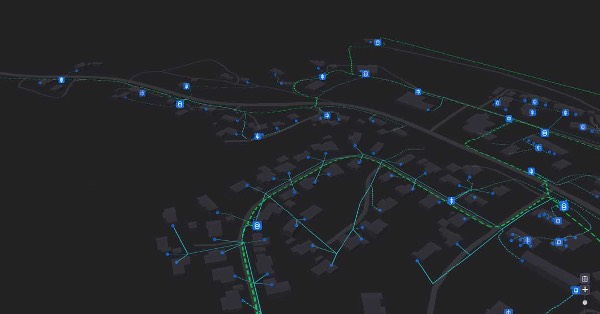The first test of a Common Information Model (CIM) profile by Kongsberg Digital, Volue, and Glitre Energi Nett was highly successful, marking an important step forward for collaboration within the energy industry.
The exchange of models and data across internal systems and businesses is becoming increasingly important in the energy industry. Different systems use their own language and have their own way of describing the components, leading to challenges in data exchange. To help solve this issue, several energy enterprises have established DIGIN, a joint initiative for digital interaction in operations and planning. CIM (Common Information Model) is a central part of the initiative.
Establishing a common CIM profile used in Norway, named “Felles Grunnprofil”, is one of DIGIN´s goals. Recently, Kongsberg Digital did a test of this profile where Glitre Energi Nett and Volue exported their grid model from NETBAS through DIGIN´s Grunnprofil, and it was imported by Kongsberg Digital. Export and import of models and data went well, marking an important step forward for collaboration within the energy industry.
“Standardization of data formats is vital to build efficient and scalable software, and our software is based on the CIM-standard. This first test using a common CIM profile is an important step in the right direction for the whole energy industry and shows promising prospects for a common data language that can contribute to cost savings, innovation initiatives, and digitalization in the energy industry”, says Lasse Jamt, VP Renewables & Utilities in Kongsberg Digital.
The CIM-profile encompasses the regional grid as well as the distribution grid, from end customer to affiliation points in the transmission grid. The purpose of the profile is to conduct power system analysis and simulations, and DIGIN has delivered its first version of this profile, called DIGN10, including a guide for modelling.
Kongsberg Digital imported the grid model to its digital twin software solution for power grids, Kognitwin. The test showed that Glitre´s grid model for load flow calculations and load prediction was available in Kognitwin within a short time.
According to Otto Andreas Rustad, system operations manager in Glitre Energi Nett, export of data from different systems is key to succeed in digitalization, however, this has shown to be a demanding task.
“Export of data is vital to succeed in digitalization. Experience shows that information exchange between two suppliers is a challenging task. Using the DIGIN profile, this was surprisingly easy. We are impressed with how quickly a complete model of our grid was exchanged”, Rustad says.
Lars Berthinussen, leader of the DIGIN program, is very pleased with the results.
“It is very positive and motivating to hear about the good experience and results Kongsberg Digital and Glitre Energi Nett made using the DIGIN common profile. We must succeed in data exchange between parties and systems to overcome the challenges we are facing in terms of electrification and the green shift in Norway. This motivates us to keep up our work in cooperation with the industry, and we are looking forward to further cooperation and feedback. We can only solve these issues by working together”, says Berthinussen
DIGIN:
- DIGIN is initiated by the energy industry to lift digital interaction across parties in the power industry.
- Working on a common data information model and standards is central
- The Common profile, Felles Grunnprofil, is one of several projects run by DIGIN with the aim of solving joint challenges in the power industry and utilizing the potential of digitalization.
CIM (Common Information Model):
- CIM is an important tool to make different systems interact.
- Is a complex standard that can be used for data exchange regarding power grids and market information.
- Sub-sets of the CIM-standard are called profiles, defining classes and types.
- CIM is an IEC standard.
Like almost every other industry today, the power system is changing. Electrification worldwide is increasing, bringing with it the challenges of stable power supply, increasing energy costs, and long-term sustainability across the energy industry. As we know, digitalization always comes up as a potential solution – but along with it, even more challenges.






































